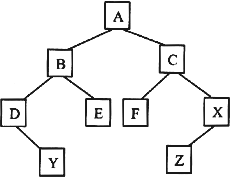问题
单项选择题
对下列二叉树
 进行前序遍历的结果为
进行前序遍历的结果为
A.DYBEAFCZX
B.YDEBFZXCA
C.ABDYECFXZ
D.ABCDEFXYZ
答案
参考答案:C
解析: 本题考查数据结构中二叉树的遍历。根据对二叉树根的访问先后顺序不同,分别称为前序遍历、中序遍历和后序遍历。这三种遍历都是递归定义的,即在其子树中也按照同样的规律进行遍历。下面就是前序遍历方法的递归定义。当二叉树的根不为空时,依次执行如下3个操作:(1)访问根结点(2)按先序遍历左子树(3)按先序遍历右子树根据如上前序遍历规则,来遍历本题中的二叉树。首先访问根结点,即A,然后遍历A的左子树。遍历左子树同样按照相同的规则首先访问根结点B,然后遍历B的左子树。遍历B的左子树,首先访问D,然后访问D的左子树,D的左子树为空,接下来访问D的右子树,即Y。遍历完B的左子树后,再遍历B的右子树,即E。到此遍历完A的左子树,接下来遍历A的右子树。按照同样的规则,首先访问C,然后遍历C的左子树,即F。C的左子树遍历完,接着遍历C的右子树。首先访问右子树的根结点X,然后访问X的左子树,X的左子树,即Z,接下来访问X的右子树,右子树为空。到此,把题目的二叉树进行了一次前序遍历。遍历的结果为 ABDYECFXZ,故本题的正确答案为选项C。
